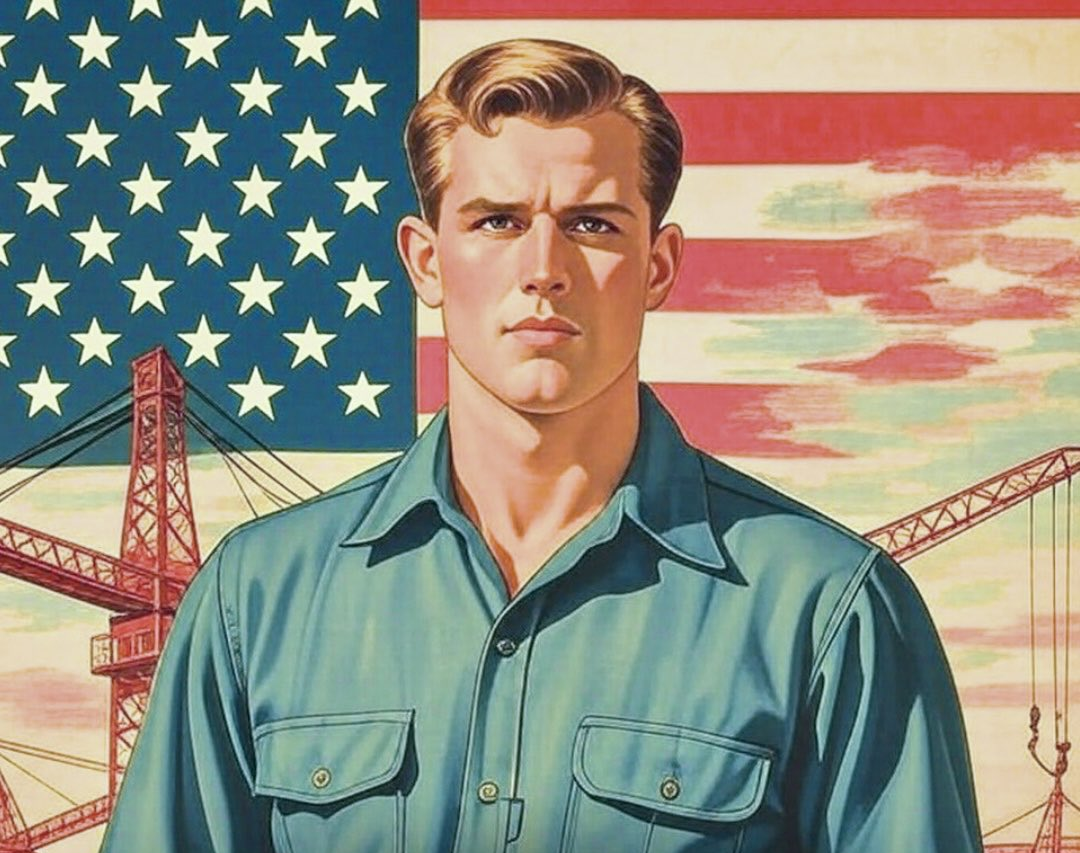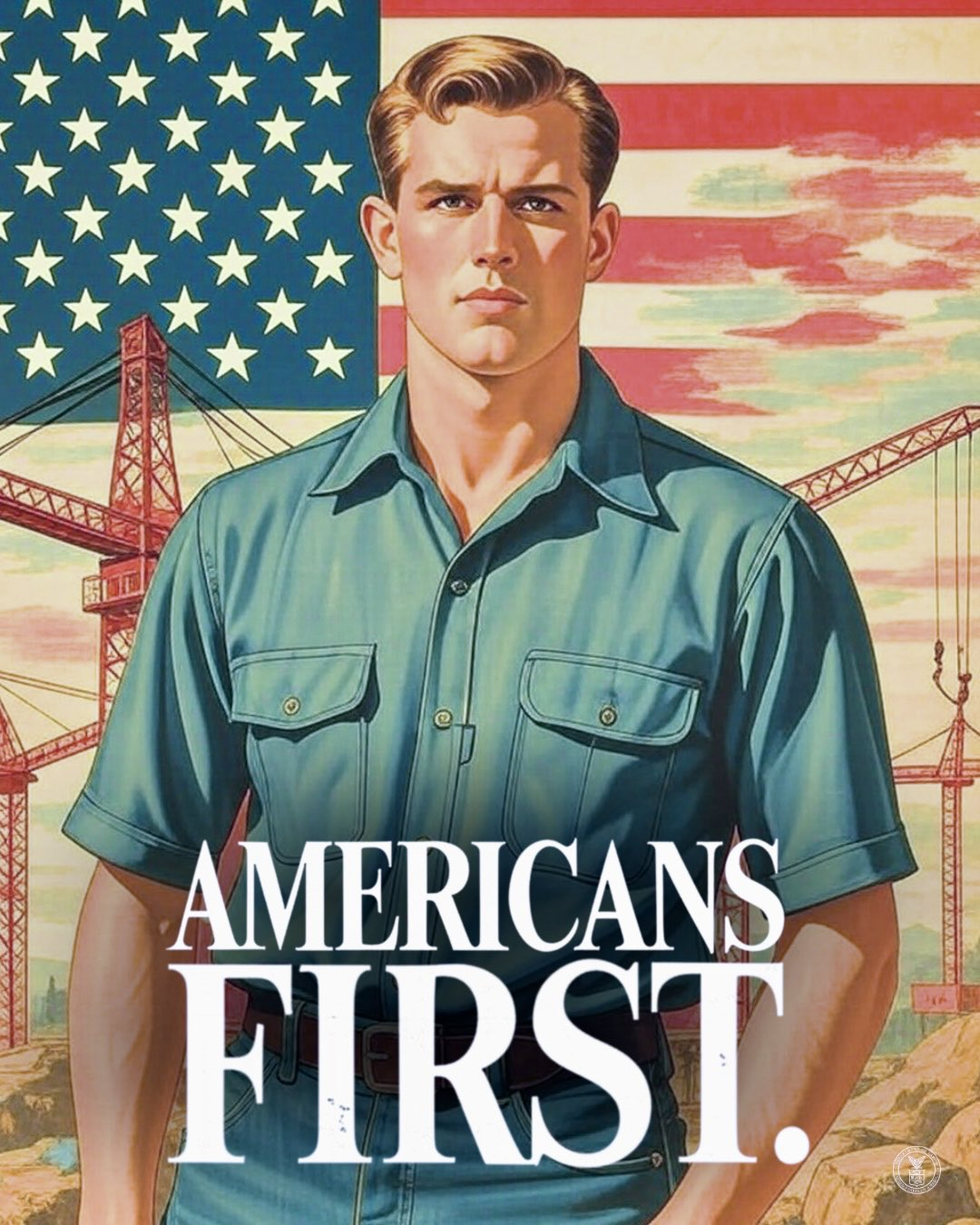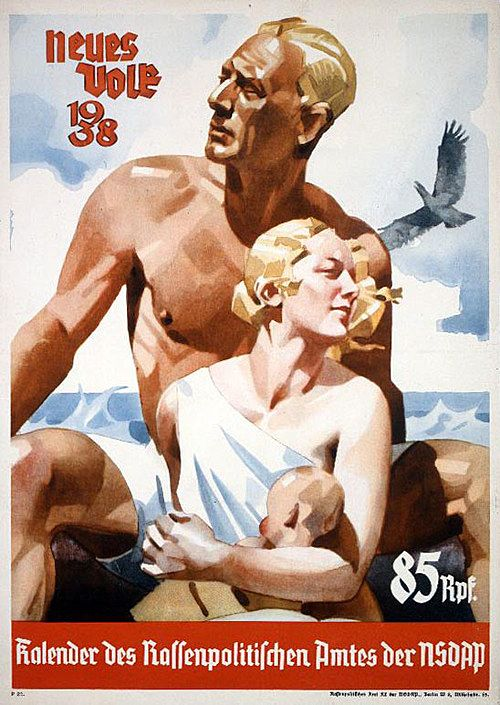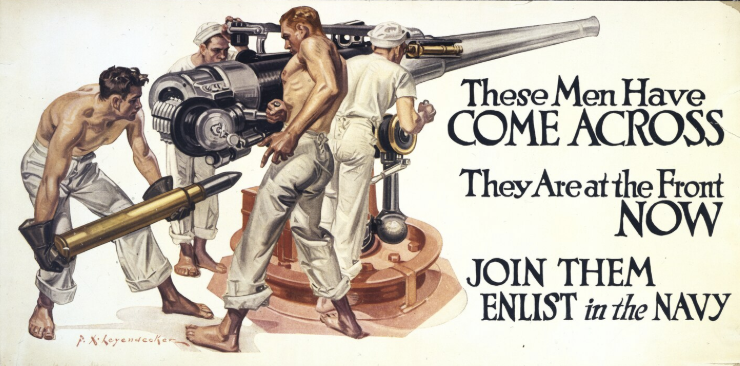U.S. Labor Department Revives Leyendecker’s Queer Vision of Masculinity


 Top: “Americans First.” posted by the U.S. Department of Labor on October 18, 2025. Above: “Built America’s Future!” posted by the U.S. Department of Labor on September 29, 2025.
Top: “Americans First.” posted by the U.S. Department of Labor on October 18, 2025. Above: “Built America’s Future!” posted by the U.S. Department of Labor on September 29, 2025.
When the Labor Department posted likely AI-generated images of White strapping young men posing in front of job sites as part of a social media campaign in September and October, art historians and everyday Americans were quick to point out their similarities to Soviet, Chinese, and German propaganda art. What has been less covered is that at the heart of these images is a pointed homoeroticism that conflicts with far-right Christian nationalism’s attempts to deny the personhood of queer and trans people. In co-opting this content, the deeply queerphobic Trump administration fails to recall how their glorification of White manhood very clearly veers into the homoerotic, especially because one of the main architects behind 20th-century masculinity used his own partner as his muse. Joseph C. Leyendecker lived with Charles Beach, who became his model, for nearly 50 years, to create iconic advertising and anti-Nazi propaganda that has come to shape U.S.-American masculinist imagery.
Reaching beyond the advertising industry, where he is best known, this past summer, the New-York Historical Society hosted an exhibition of Leyendecker’s work titled “Under Cover: J. C. Leyendecker and American Masculinity.” It dove deep into how his advertising artistry, selling razors and clothing (and even gracing the covers of The Saturday Evening Post), and governmental posters and ads that mobilized recruitment during World War I and II molded a generation’s ideas surrounding a Christian masculinity. In fact, even President Theodore Roosevelt—himself an advocate for manly athleticism—called Leyendecker’s work “a superb example of the common man.”


20th-century Soviet, Chinese, and German propaganda posters featuring Chinese and Soviet men holding hands, kissing, and embracing one another exude the same strength and sensuality as Leyendecker’s earlier paintings of White, muscular young men. While this affection reflects the Communist regimes’ goals of cultural unification, Zipeng Zhu and film historian Bader AlAwadhin pushed further at the Poster House museum’s 2021 panel discussion “The Gay Agenda: Homoeroticism in Communist Propaganda.” Zhu shared with Eye on Design that “many of the artists commissioned to make these posters were probably in the queer community. “They were trying to be rebellious in a very clever way, and I don’t think the Communist party was really aware of the code artists were sending out using public propaganda,” Zhu continued during the panel.
While AiAwadhi asserts that there is little documented evidence of intentionally depicting homosexuality in the propaganda, especially under deeply homophobic regimes in the Soviet Union (and later Russia) and Nazi Germany. Fraternal hugging and even kissing were not uncommon among men, but are now seen as homoerotic by Western readers, reaffirming its subliminal (possibly intentional) homoeroticism in a contemporary context.


In his examination of homoeroticism in Nazi art, Tim Pursell cites scholar Roland Barthes who argues that the meaning of an object or a work of art is always “polysemous,” or specifically shaped by the person who views it and their cultural context. And the perhaps unintentional homoeroticism of the art of the Third Reich, Pursell argues, may have even titillated the artists’ contemporaries, including gay erotic artist Tom of Finland who became enraptured by the rippling masculinity of National Socialist art.
While Leyendecker created some of the most iconic anti-Nazi imagery of the 20th century, his work (like that of other propaganda artists) has been co-opted by white nationalists to promote their own agenda. In 2017, one of Leyendecker’s illustrations from The Saturday Evening Post was reprinted on a flyer that appeared outside the Student Union at Portland State University. Modified to show the muscular White man wearing a shirt with the words “white pride,” the flyer advertised for the alt-right movement Cascadia with the caption “White. Proud. Unapologetic.”
When the Labor Department and the Department of Homeland Security likely used AI to generate images of muscular White male workers in front of oil rigs and smoke stacks, the result will draw on historical examples of German, Soviet, Chinese, and American propaganda—the latter by Leyendecker—that are pointedly homoerotic. While historians may never explicitly know if the homoeroticism of Chinese and Soviet Communist workers hugging and kissing was intentional, Leyendecker’s queerness did inform his vision of masculinity.
Yet, White supremacists and Christian nationalists in the US government and across the United States forget this history as they wage wars against undocumented individuals and queer and trans people just trying to exist. They sure do a good job of denying the queerness within their own administration. But there is a strong and influential queer community within the Republican Party. Neil J. Young’s book Coming Out Republican covers in detail how the gay Right emboldened the MAGA cause, all while calls to overturn marriage equality and conversion therapy bans get louder. Influenced by Leyendecker, the new poster campaign reflects how homoeroticism is an integral part of the image of Christian U.S.-American masculinity.
In short, the Labor Department has ushered in a new era targeted at equating manhood with service that tethers the Manoverse that got Trump elected to its White supremacist propaganda that is both chauvinistic and homoerotic.
You Might Also Like
What's Your Reaction?
Emma Cieslik (she/her) is a queer, disabled, and neurodivergent museum professional and writer based in Washington, DC. She is also a religious scholar interested in the intersections of religion, gender, sexuality, and material culture, especially focused on queer religious identity and accessible histories.

